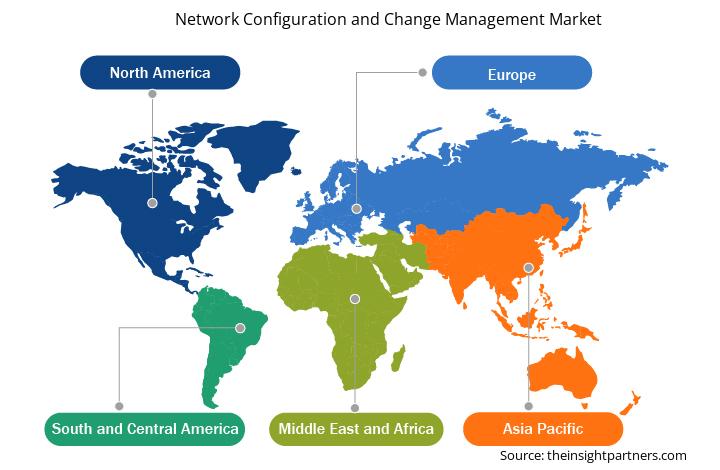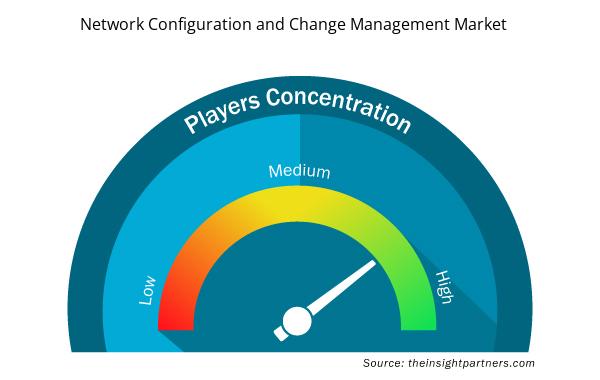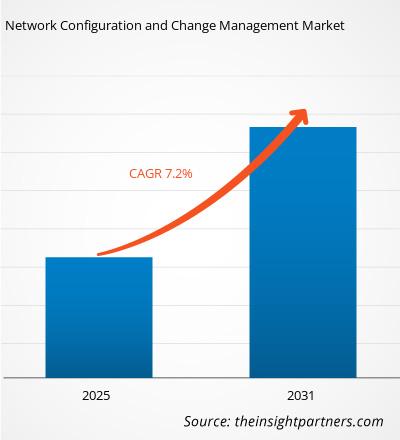من المتوقع أن يسجل سوق تكوين الشبكة وإدارة التغيير معدل نمو سنوي مركب بنسبة 7.2٪ من عام 2025 إلى عام 2031، مع توسع حجم السوق من XX مليون دولار أمريكي في عام 2024 إلى XX مليون دولار أمريكي بحلول عام 2031.
يُقسّم التقرير حسب المكونات (البرمجيات، الخدمات (الدعم، الاستشارات))، النشر (داخل المؤسسة، حسب الطلب)، حجم المؤسسة (الشركات الصغيرة والمتوسطة، المؤسسات الكبرى)، القطاعات (قطاعات الخدمات المصرفية والمالية والتأمين، تكنولوجيا المعلومات والاتصالات، الحكومة، الطاقة، الرعاية الصحية، قطاعات أخرى). ويُفصّل التحليل العالمي بشكل أكبر على المستوى الإقليمي والدول الرئيسية. ويُقدّم التقرير القيمة بالدولار الأمريكي للتحليل والقطاعات المذكورة أعلاه.
غرض التقرير
يهدف تقرير "سوق تكوين الشبكات وإدارة التغيير" الصادر عن شركة "إنسايت بارتنرز" إلى وصف المشهد الحالي والنمو المستقبلي، وأهم العوامل المحفزة، والتحديات، والفرص المتاحة. وسيوفر هذا التقرير رؤى ثاقبة لمختلف أصحاب المصلحة في قطاع الأعمال، مثل:
- مزودي التكنولوجيا/المصنعين: لفهم ديناميكيات السوق المتطورة ومعرفة فرص النمو المحتملة، وتمكينهم من اتخاذ قرارات استراتيجية مستنيرة.
- المستثمرون: إجراء تحليل شامل للاتجاهات فيما يتعلق بمعدل نمو السوق، والتوقعات المالية للسوق، والفرص المتاحة عبر سلسلة القيمة.
- الهيئات التنظيمية: لتنظيم السياسات ومراقبة الأنشطة في السوق بهدف تقليل الانتهاكات والحفاظ على ثقة المستثمرين ودعم سلامة السوق واستقرارها.
تجزئة سوق تكوين الشبكة وإدارة التغيير
عناصر
- برمجة
- خدمات
النشر
- في الموقع
- حسب الطلب
حجم المنظمة
- الشركات الصغيرة والمتوسطة
- الشركات
عموديات
- الخدمات المصرفية والمالية والتأمين
- تكنولوجيا المعلومات والاتصالات
- حكومة
- طاقة
- الرعاية الصحية
قم بتخصيص هذا التقرير ليناسب متطلباتك
ستحصل على تخصيص لأي تقرير - مجانًا - بما في ذلك أجزاء من هذا التقرير، أو تحليل على مستوى الدولة، وحزمة بيانات Excel، بالإضافة إلى الاستفادة من العروض والخصومات الرائعة للشركات الناشئة والجامعات
سوق تكوين الشبكة وإدارة التغيير: رؤى استراتيجية

- احصل على أهم اتجاهات السوق الرئيسية لهذا التقرير.ستتضمن هذه العينة المجانية تحليل البيانات، بدءًا من اتجاهات السوق وحتى التقديرات والتوقعات.
عوامل نمو سوق تكوين الشبكة وإدارة التغيير
- تزايد الطلب على كفاءة الطاقة: يُعدّ الطلب العالمي المتزايد على كفاءة الطاقة والاستدامة محركًا رئيسيًا لسوق طاقة إنترنت الأشياء. تتيح الأجهزة والشبكات الذكية المُدعّمة بإنترنت الأشياء المراقبة الفورية، وتحسين استهلاك الطاقة، وتقليل الهدر. تُساعد هذه التقنية شركات المرافق العامة والشركات على تحسين إدارة الطاقة، وخفض تكاليف التشغيل، والالتزام باللوائح البيئية، مما يُعزز نمو السوق في ظل سعي المستهلكين والقطاعات المختلفة إلى حلول طاقة أكثر كفاءة.
- اللوائح الحكومية وأهداف الاستدامة: تُطبّق الحكومات حول العالم لوائح وأهدافًا أكثر صرامةً للاستدامة، مما يدفع القطاعات إلى خفض استهلاك الطاقة وانبعاثات الكربون. تُمكّن الحلول القائمة على إنترنت الأشياء، مثل العدادات الذكية وأنظمة إدارة الطاقة، الشركات من الامتثال لهذه اللوائح من خلال توفير بيانات مُفصّلة والتحكم في استخدام الطاقة. يُحفّز هذا التوجه التنظيمي اعتماد تقنيات إنترنت الأشياء في قطاع الطاقة.
- التطورات في تكنولوجيا الشبكات الذكية: يُحدث دمج إنترنت الأشياء في الشبكات الذكية ثورةً في سوق الطاقة. فمن خلال تمكين التواصل الفوري بين مصادر توليد الطاقة ووحدات التخزين والمستهلكين، يُسهم إنترنت الأشياء في تعزيز كفاءة الشبكة واستقرارها وأدائها. كما تُسهّل الشبكات الذكية الصيانة التنبؤية والكشف الآلي عن الأعطال، مما يُعزز الطلب على حلول إنترنت الأشياء التي تضمن إدارةً أفضل للشبكة وتوزيعًا أفضل للطاقة.
اتجاهات مستقبل سوق تكوين الشبكة وإدارة التغيير
- دمج الذكاء الاصطناعي والتعلم الآلي لإدارة التغييرات التنبؤية: يُعد دمج الذكاء الاصطناعي والتعلم الآلي (ML) في إدارة تغييرات تكوين الشبكة توجهًا ناشئًا. تستطيع هذه التقنيات تحليل البيانات التاريخية، ومراقبة سلوك الشبكة، والتنبؤ بالمشاكل المحتملة قبل حدوثها. على سبيل المثال، تستطيع أدوات إدارة التغيير في تكوين الشبكة (NCCM) المدعومة بالذكاء الاصطناعي اكتشاف أنماط سوء التكوين أو التنبؤ بنتائج تغييرات محددة بناءً على البيانات التاريخية، مما يسمح لمسؤولي الشبكة بمعالجة المشاكل بشكل استباقي. تعزز هذه القدرة التنبؤية الكفاءة وتساعد على منع فترات التوقف المكلفة أو الانقطاعات الناجمة عن أخطاء التكوين.
- حلول إدارة تكوين الشبكة السحابية: يُحفّز تبني السحابة التحول نحو منصات إدارة التكوين السحابية. تُوفّر هذه المنصات للمؤسسات مرونةً أكبر وقابليةً للتوسّع وسهولةً في الوصول مقارنةً بالحلول التقليدية المحلية. تُتيح أدوات إدارة تكوين الشبكة السحابية (NCCM) لمسؤولي الشبكات إدارة التكوينات من أي مكان، وتُقلّل الحاجة إلى بنية تحتية مُخصّصة، وتُسهّل التعاون بين الفرق المُوزّعة جغرافيًا. كما يُساعد هذا التوجّه نحو الحلول السحابية المؤسسات على تبسيط عمليات الإدارة لديها، وخفض التكاليف، وضمان نشر تغييرات التكوين بشكل أسرع وأكثر كفاءة.
فرص سوق تكوين الشبكات وإدارة التغيير
- التوسع في البيئات الهجينة ومتعددة السحابات: مع تزايد عدد المؤسسات التي تتبنى البيئات الهجينة ومتعددة السحابات، تزداد الحاجة إلى إدارة تغييرات تكوين الشبكة التي تشمل الشبكات المحلية والسحابية. تتطلب إدارة التكوينات عبر بيئات متنوعة - بما في ذلك السحابات العامة والخاصة والهجينة - أدوات قوية وقابلة للتطوير، تتكامل بسلاسة مع مختلف منصات السحابة والأجهزة المحلية. ويتمتع مزودو حلول إدارة التكوينات الشبكية بفرصة كبيرة لتطوير حلول توفر رؤية وتحكمًا شاملين عبر مراكز البيانات التقليدية والبنى التحتية السحابية الحديثة.
- اعتماد الشركات الصغيرة والمتوسطة لحلول إدارة تغيير إعدادات الشبكة المتقدمة: في حين أدركت الشركات الكبيرة منذ زمن طويل أهمية إدارة تغيير إعدادات الشبكة، إلا أن الشركات الصغيرة والمتوسطة تتبنى هذه الحلول بشكل متزايد لتوسيع شبكاتها. ومع تزايد توفر أدوات إدارة تغيير إعدادات الشبكة بأسعار معقولة وسهلة النشر، أصبح بإمكان الشركات الصغيرة والمتوسطة الآن الوصول إلى إمكانيات إدارة الشبكة التي كانت حكرًا في السابق على الشركات الكبيرة. ويمثل هذا فرصة نمو كبيرة للموردين لتقديم حلول أكثر فعالية من حيث التكلفة وسهولة في الاستخدام، مصممة خصيصًا لتلبية احتياجات الشركات الصغيرة والمتوسطة. ومن خلال تمكين الشركات الصغيرة والمتوسطة من تحسين إعدادات شبكاتها وتأمينها، يمكن لمقدمي الخدمات الاستفادة من شريحة سوقية متنامية أصبحت أكثر وعيًا بالمخاطر التي تشكلها ممارسات إدارة التكوين السيئة.
رؤى إقليمية حول سوق تكوين الشبكة وإدارة التغيير
قام محللو إنسايت بارتنرز بشرح شامل للاتجاهات والعوامل الإقليمية المؤثرة في سوق تكوين الشبكات وإدارة التغيير خلال فترة التوقعات. ويناقش هذا القسم أيضًا قطاعات سوق تكوين الشبكات وإدارة التغيير ونطاقه الجغرافي في أمريكا الشمالية، وأوروبا، وآسيا والمحيط الهادئ، والشرق الأوسط وأفريقيا، وأمريكا الجنوبية والوسطى.

- احصل على البيانات الإقليمية المحددة لسوق تكوين الشبكة وإدارة التغيير
نطاق تقرير سوق تكوين الشبكة وإدارة التغيير
| سمة التقرير | تفاصيل |
|---|---|
| حجم السوق في عام 2024 | XX مليون دولار أمريكي |
| حجم السوق بحلول عام 2031 | XX مليون دولار أمريكي |
| معدل النمو السنوي المركب العالمي (2025 - 2031) | 7.2% |
| البيانات التاريخية | 2021-2023 |
| فترة التنبؤ | 2025-2031 |
| القطاعات المغطاة | حسب المكونات
|
| المناطق والدول المغطاة | أمريكا الشمالية
|
| قادة السوق وملفات تعريف الشركات الرئيسية |
|
كثافة اللاعبين في سوق تكوين الشبكة وإدارة التغيير: فهم تأثيرها على ديناميكيات الأعمال
يشهد سوق تكوين الشبكات وإدارة التغيير نموًا سريعًا، مدفوعًا بتزايد طلب المستخدمين النهائيين نتيجةً لعوامل مثل تطور تفضيلات المستهلكين، والتقدم التكنولوجي، وزيادة الوعي بمزايا المنتج. ومع تزايد الطلب، تعمل الشركات على توسيع عروضها، والابتكار لتلبية احتياجات المستهلكين، والاستفادة من الاتجاهات الناشئة، مما يُعزز نمو السوق.
تشير كثافة اللاعبين في السوق إلى توزيع الشركات العاملة في سوق أو قطاع معين. وتشير إلى عدد المنافسين (اللاعبين في السوق) الموجودين في سوق معين نسبةً إلى حجمه أو قيمته السوقية الإجمالية.
الشركات الرئيسية العاملة في سوق تكوين الشبكة وإدارة التغيير هي:
- إدارة المحرك
- إتش بي إي
- سولارويندز
- ساينس لوجيك
- سيسكو
- مجرى النهر
إخلاء المسؤولية : الشركات المذكورة أعلاه ليست مرتبة بأي ترتيب معين.

- احصل على نظرة عامة على أهم اللاعبين الرئيسيين في سوق تكوين الشبكة وإدارة التغيير
نقاط البيع الرئيسية
- التغطية الشاملة: يغطي التقرير بشكل شامل تحليل المنتجات والخدمات والأنواع والمستخدمين النهائيين لسوق تكوين الشبكة وإدارة التغيير، مما يوفر مشهدًا شاملاً.
- تحليل الخبراء: تم تجميع التقرير على أساس الفهم العميق لخبراء الصناعة والمحللين.
- معلومات محدثة: يضمن التقرير أهمية الأعمال التجارية بسبب تغطيته للمعلومات الحديثة واتجاهات البيانات.
- خيارات التخصيص: يمكن تخصيص هذا التقرير لتلبية متطلبات العملاء المحددة وتلبية استراتيجيات العمل بشكل مناسب.
لذا، يُمكن لتقرير البحث حول سوق تكوين الشبكات وإدارة التغيير أن يُساعد في تمهيد الطريق لفهم سيناريوهات هذه الصناعة وآفاق نموها. ورغم وجود بعض المخاوف المُبررة، إلا أن فوائد هذا التقرير الإجمالية تفوق عيوبه.
- التحليل التاريخي (سنتان)، السنة الأساسية، التوقعات (7 سنوات) مع معدل النمو السنوي المركب
- تحليل PEST و SWOT
- حجم السوق والقيمة / الحجم - عالميًا وإقليميًا وقطريًا
- الصناعة والمنافسة
- مجموعة بيانات Excel


- Sterilization Services Market
- Sleep Apnea Diagnostics Market
- Photo Editing Software Market
- Extracellular Matrix Market
- Aquaculture Market
- Cut Flowers Market
- Hydrocephalus Shunts Market
- Hot Melt Adhesives Market
- Emergency Department Information System (EDIS) Market
- Lyophilization Services for Biopharmaceuticals Market

Report Coverage
Revenue forecast, Company Analysis, Industry landscape, Growth factors, and Trends

Segment Covered
This text is related
to segments covered.

Regional Scope
North America, Europe, Asia Pacific, Middle East & Africa, South & Central America

Country Scope
This text is related
to country scope.
الأسئلة الشائعة
Some of the customization options available based on the request are an additional 3–5 company profiles and country-specific analysis of 3–5 countries of your choice. Customizations are to be requested/discussed before making final order confirmation# as our team would review the same and check the feasibility
The report can be delivered in PDF/PPT format; we can also share excel dataset based on the request
AI and Machine Learning Integration for Predictive Change Management and Cloud-Based Network Configuration Management Solutions is anticipated to play a significant role in the global Network Configuration and Change Management market in the coming years.
The major factors driving the Network Configuration and Change Management market are Increasing Network Complexity and Scalability, Growing Cybersecurity Threats and Compliance Regulations and Digital Transformation and Network Automation.
The Network Configuration and Change Management market is estimated to witness a CAGR of 7.2% from 2024 to 2031.
Trends and growth analysis reports related to Technology, Media and Telecommunications : READ MORE..
The Insight Partners performs research in 4 major stages: Data Collection & Secondary Research, Primary Research, Data Analysis and Data Triangulation & Final Review.
- Data Collection and Secondary Research:
As a market research and consulting firm operating from a decade, we have published and advised several client across the globe. First step for any study will start with an assessment of currently available data and insights from existing reports. Further, historical and current market information is collected from Investor Presentations, Annual Reports, SEC Filings, etc., and other information related to company’s performance and market positioning are gathered from Paid Databases (Factiva, Hoovers, and Reuters) and various other publications available in public domain.
Several associations trade associates, technical forums, institutes, societies and organization are accessed to gain technical as well as market related insights through their publications such as research papers, blogs and press releases related to the studies are referred to get cues about the market. Further, white papers, journals, magazines, and other news articles published in last 3 years are scrutinized and analyzed to understand the current market trends.
- Primary Research:
The primarily interview analysis comprise of data obtained from industry participants interview and answers to survey questions gathered by in-house primary team.
For primary research, interviews are conducted with industry experts/CEOs/Marketing Managers/VPs/Subject Matter Experts from both demand and supply side to get a 360-degree view of the market. The primary team conducts several interviews based on the complexity of the markets to understand the various market trends and dynamics which makes research more credible and precise.
A typical research interview fulfils the following functions:
- Provides first-hand information on the market size, market trends, growth trends, competitive landscape, and outlook
- Validates and strengthens in-house secondary research findings
- Develops the analysis team’s expertise and market understanding
Primary research involves email interactions and telephone interviews for each market, category, segment, and sub-segment across geographies. The participants who typically take part in such a process include, but are not limited to:
- Industry participants: VPs, business development managers, market intelligence managers and national sales managers
- Outside experts: Valuation experts, research analysts and key opinion leaders specializing in the electronics and semiconductor industry.
Below is the breakup of our primary respondents by company, designation, and region:

Once we receive the confirmation from primary research sources or primary respondents, we finalize the base year market estimation and forecast the data as per the macroeconomic and microeconomic factors assessed during data collection.
- Data Analysis:
Once data is validated through both secondary as well as primary respondents, we finalize the market estimations by hypothesis formulation and factor analysis at regional and country level.
- Macro-Economic Factor Analysis:
We analyse macroeconomic indicators such the gross domestic product (GDP), increase in the demand for goods and services across industries, technological advancement, regional economic growth, governmental policies, the influence of COVID-19, PEST analysis, and other aspects. This analysis aids in setting benchmarks for various nations/regions and approximating market splits. Additionally, the general trend of the aforementioned components aid in determining the market's development possibilities.
- Country Level Data:
Various factors that are especially aligned to the country are taken into account to determine the market size for a certain area and country, including the presence of vendors, such as headquarters and offices, the country's GDP, demand patterns, and industry growth. To comprehend the market dynamics for the nation, a number of growth variables, inhibitors, application areas, and current market trends are researched. The aforementioned elements aid in determining the country's overall market's growth potential.
- Company Profile:
The “Table of Contents” is formulated by listing and analyzing more than 25 - 30 companies operating in the market ecosystem across geographies. However, we profile only 10 companies as a standard practice in our syndicate reports. These 10 companies comprise leading, emerging, and regional players. Nonetheless, our analysis is not restricted to the 10 listed companies, we also analyze other companies present in the market to develop a holistic view and understand the prevailing trends. The “Company Profiles” section in the report covers key facts, business description, products & services, financial information, SWOT analysis, and key developments. The financial information presented is extracted from the annual reports and official documents of the publicly listed companies. Upon collecting the information for the sections of respective companies, we verify them via various primary sources and then compile the data in respective company profiles. The company level information helps us in deriving the base number as well as in forecasting the market size.
- Developing Base Number:
Aggregation of sales statistics (2020-2022) and macro-economic factor, and other secondary and primary research insights are utilized to arrive at base number and related market shares for 2022. The data gaps are identified in this step and relevant market data is analyzed, collected from paid primary interviews or databases. On finalizing the base year market size, forecasts are developed on the basis of macro-economic, industry and market growth factors and company level analysis.
- Data Triangulation and Final Review:
The market findings and base year market size calculations are validated from supply as well as demand side. Demand side validations are based on macro-economic factor analysis and benchmarks for respective regions and countries. In case of supply side validations, revenues of major companies are estimated (in case not available) based on industry benchmark, approximate number of employees, product portfolio, and primary interviews revenues are gathered. Further revenue from target product/service segment is assessed to avoid overshooting of market statistics. In case of heavy deviations between supply and demand side values, all thes steps are repeated to achieve synchronization.
We follow an iterative model, wherein we share our research findings with Subject Matter Experts (SME’s) and Key Opinion Leaders (KOLs) until consensus view of the market is not formulated – this model negates any drastic deviation in the opinions of experts. Only validated and universally acceptable research findings are quoted in our reports.
We have important check points that we use to validate our research findings – which we call – data triangulation, where we validate the information, we generate from secondary sources with primary interviews and then we re-validate with our internal data bases and Subject matter experts. This comprehensive model enables us to deliver high quality, reliable data in shortest possible time.

 احصل على عينة مجانية لهذا التقرير
احصل على عينة مجانية لهذا التقرير